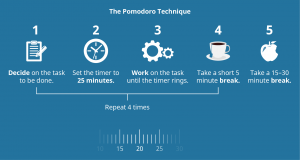Time Management
Linda Clark

Introduction
Commonly, students in higher education face challenges from poor time management. While it may not be possible to prevent life’s problems while you are at university, you can do a great deal to prevent the challenges that they can cause. This can be accomplished through thoughtful prioritisation and time management efforts. This chapter provides a close look at the nature of time management and how to identify your time management style. You will learn how to conduct a time audit of your life and create a semester, weekly and daily plan. Following this, an examination of how to break up tasks into manageable time frames and tips from three proven time management strategies will help keep you on track to graduate from university on time.
Time Management at University
You may find that time management at university is different from anything you have experienced previously. Even in the workplace, activities and time spent on tasks are monitored by the company and its management. At university, time management is left up to you. While it is true that there are assignment due dates and organised classroom activities, learning at the university level requires more than just the simple completion of work. It involves decision-making and the ability to evaluate information. This is best accomplished when you are an active partner in your own learning activities.
You can expect to spend much more time on learning activities outside the classroom than you will in the classroom. Most courses have a workload of 165 hours each semester. This is a workload of 10-12 hours each week needed to attend or listen to lectures and tutorials, prepare for assessments, and to read study material. Some weeks may be more intense, depending on the time of the semester and the courses you are taking. Not only will what you do be larger in scale, but the depth of understanding and knowledge you will put into it will be significantly more than you may have encountered previously. This is because there are greater expectations required of university graduates in the workplace. Nearly any profession that requires a university degree has with it a level of responsibility that demands higher-level thinking and therefore higher learning.
Identifying your time management style
Managing time and prioritising tasks are not only valuable skills for pursuing an education, but they can become abilities that follow you through the rest of your life, especially if your career takes you into a leadership role (see Figure 13.2).

Table 13.1 is an exercise that is intended to help you recognise some things about your own time management style, and identify any areas where you might be able to improve. Tick the box that best represents your position on each statement.
Table 13.1 Time management
| Statement | Always | Usually | Sometimes | Rarely | Never |
| I like to be given strict deadlines for each task. It helps me stay organised and on track. | |||||
| I would rather be 15 minutes early than one minute late. | |||||
| I like to improvise instead of planning everything out ahead of time. | |||||
| I prefer to be able to manage when and how I do each task. | |||||
| I have a difficult time estimating how long a task will take. | |||||
| I have more motivation when there is an upcoming deadline. It helps me focus. | |||||
| I have difficulty keeping priorities in the most beneficial order. |
When you have finished, consider what your answers mean in regard to potential strengths and/or challenges for you when it comes to time management in university. If you are a person who likes strict deadlines, what would you do if you took a course that only had one large paper due at the end? Would you set yourself a series of mini deadlines that made you more comfortable and that kept things moving along for you? Or, if you have difficulty prioritising tasks, would it help you to make a list of the tasks to do and order them, so you know which ones must be finished first?
Time Audit
The simplest way to manage your time is to plan accurately for how much time it will take to do each task, and then set aside that amount of time. How you divide the time is up to you. If it is going to take you five hours to study for a final exam, you can plan to spread it over five days, with an hour each night, or you can plan on two hours one night and three hours the next.
This approach however relies on being able to estimate time accurately. Many people are not truly aware of how they actually spend their time. To get organised and plan for the semester ahead, you will need to consider study and non-study commitments. Conduct an audit on how much time you spend on aspects of your daily life. Include studying, working, sleeping, eating, caring for others, socialising, household chores and exercising. This will allow you to see where your time is going and where you could achieve some better balance for your life, work and study.
In this activity, write down all the things you think you will do tomorrow, and estimate the time you will spend doing each (see Table 13.2). Then track each thing you have written down to see how accurate your estimates were. After you have completed this activity for a single day, you may consider completing another time audit for an entire week so that you are certain to include all of your activities.
Table 13.2 Sample time estimate table
| Daily activity | Estimate time | Actual time |
| Practice quiz | 5 minutes | 15 minutes |
| Lab conclusions | 20 minutes | 35 minutes |
| Food shopping | 45 minutes | 30 minutes |
| Drive to work | 20 minutes | 20 minutes |
| Work | 4 hours | 4 hours |
| Physical therapy | 1 hour | 50 minutes |
Planning your semester
Now that you have audited your time and you know how much time is required in all areas of your life you can now make a plan. It is important to view your time in three different ways - semester, weekly and daily.
Semester view
- Make a plan of the whole semester. A yearly wall calendar is useful for this.
- Add assignment due dates and exam blocks
- Add class or lab attendance requirements
- Include other significant commitments, for example, work or family commitments identified in your time audit.
Weekly view
- Consider the tasks you need to complete each week to meet the expectations of your course such as weekly readings or tutorial preparation.
- Allocate time for exam preparation, tutorial preparation and time to work on upcoming assignments.
Daily view
- Write daily ‘to do’ lists
- Use time management apps on your phone to set reminders
- Allow for some flexibility
Breaking Tasks Down
Of all the parts of time management, accurately predicting how long a task will take is usually the most difficult. What makes it challenging to estimate accurately time spent on-task is that you must also account for things like interruptions or unforeseen problems that cause delays. When it comes to academic activities, many tasks can be dependent upon the completion of other things first, or the time a task takes can vary from one instance to another. For example, if a lecturer assigned you three chapters of reading, you would not know how long each chapter might take to read until you looked at them. The first chapter might be 30 pages long while the second is 45. The third chapter could be only 20 pages but made up mostly of charts and graphs for you to compare. By page count, it might seem that the third chapter would take the least amount of time, but actually studying charts and graphs to gather information can take longer than regular reading.
The concept behind the next strategy discussed is to break tasks into smaller, more manageable units that do not require as much time to complete. As an illustration of how this might work, imagine that you are assigned a two-page essay that is to include references. You estimate that to complete the essay would take you between four and five hours. You look at your calendar over the next week and see that there simply are no open five-hour blocks. While looking at your calendar, you do see that you can squeeze in an hour every night. Instead of trying to write the entire paper in one sitting, you break it up into much smaller components as shown in the table below (see Table 13.3).
Table 13.3 Breaking down projects into even small chunks.
| Monday | Tuesday | Wednesday | Thursday | Friday | Saturday | Sunday | |
| 8:00 a.m. –10:00 a.m. | Work | Work | Work | ||||
| 10:00 a.m - 12:00 p.m | Algebra | Work | Algebra | Work | Algebra | 10 a.m. - 11 a.m. only if needed | Work |
| 12:00 p.m. - 2:00 p.m. | Lunch/study | 1pm English comp | Lunch/study | 1pm English comp | Lunch/study | Family picnic | |
| 2:00 p.m. - 4:00 p.m | History | English comp | History | English comp | History | Family picnic | |
| 4:00 p.m. - 6:00 p.m. | Study for algebra quiz | Grocery | Study for history exam | Study for history exam | Research 5 p.m. -6 p.m. Rewrite and polish final draft | Family picnic | Laundry |
| 6:00 p.m - 7:00 p.m | Write outline: look for references | Research references to support outline; look for good quotes | Research presentation project | Write second page and closing draft | Create presentation | Meet with Darcy | Prepare university stuff for next week |
| 7:00 p.m. - 8:00 p.m. | Free time | Free time | Write paper introduction and first page draft | Research presentation project | Create presentation | Free time | |
You could use a variation of the Pomodoro Technique discussed in the next section and write for three 20-minute segments each day at different times. The key is to look for ways to break down the entire task into smaller steps and spread them out to fit your schedule.
Three Strategies for Time Management

There are three helpful time management strategies that have been used by students successfully for many year – Daily Top Three, Pomodoro Technique and Eat the Frog. Try them out and see how they work for you.
Daily Top Three
The idea behind the daily top three approach is that you determine which three things are the most important to finish that day, and these become the tasks that you complete. It is a very simple technique that is effective because each day you are finishing tasks and removing them from your list. Even if you took one day off a week and completed no tasks on that particular day, a daily top three strategy would have you finishing 18 tasks in the course of a single week. That is a good number of things crossed off your list.
Pomodoro Technique
The Pomodoro Technique allows you to tackle one task at a time with high intensity before taking a short-timed break, and then repeating this process (see Figure 13.4). The Pomodoro Technique recommends 25 minutes of work and then a five-minute break, and after two hours of this, a longer break of 15-30 minutes (Cirillo, n.d). Be flexible in your approach, for example you don’t have to stop after 25 minutes if you are working well, or you may restart your 25 minutes if you get distracted. To make the most of this technique, plan your tasks ahead of time and be specific about what you want to achieve during each time block.

Eat the Frog
Of our three quick strategies, eat the frog probably has the strangest name and may not sound the most inviting. The name comes from a famous quote, attributed to Mark Twain: “Eat a live frog first thing in the morning and nothing worse will happen to you the rest of the day.” How this applies to time and task management is based on the concept that if a person takes care of the biggest or most unpleasant task first, everything else will be easier after that.
We greatly underestimate how much worry can impact our performance. If you are continually distracted by anxiety over a task you are dreading, it can affect the task you are working on at the time. Not only will you have a sense of accomplishment and relief when the task you are concerned with is finished and out of the way, but other tasks will seem lighter and not as difficult.
Conclusion
We all lead busy lives and managing your time effectively while you are studying at university can mean the difference between success and failure. By managing your time and using some positive strategies, you can give yourself the best possible chance of successful study outcomes.
Key points
- Time management at university level is up to you.
- Expect to spend more time on learning outside of the classroom than you will inside the classroom.
- Identify your time management style to help you create deadlines.
- Consider study and non-study commitments when auditing your time to help you to see where your time goes.
- Plan your semester first, add weekly tasks, and then make a ‘to do’ list for daily tasks.
- Break large tasks into small blocks of time which will fit into your schedule.
- Use the Daily Top Three to write down three tasks that are important to finish that day.
- Use the Pomodoro Technique to work on one task for a 25-minute period. then take a five-minute break then repeat until you have been working for two hours.
- Use Eat the Frog to take care of the biggest task first so that everything else seems easier after that.
References
Cirillo, F. (n.d). The Pomodoro Technique. Cirillo Consulting. https://francescocirillo.com/pages/pomodoro-technique

